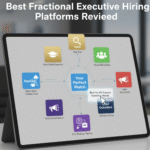In today’s fast-paced technological landscape, the need for IT modernization has never been more urgent. Companies are increasingly turning to fractional executives to drive this transformation. These seasoned professionals bring a wealth of experience and a fresh perspective, helping businesses navigate the complexities of modern IT strategies. This post explores how fractional executives contribute to IT modernization and why they become indispensable assets for forward-thinking organizations.
Understanding Fractional Executives
Fractional IT executives are part-time leaders who provide strategic expertise and support without the commitment of a full-time position. They often have extensive experience in their respective fields, bringing a level of knowledge and strategic thinking that can drive significant advancements in IT modernization. For instance, these professionals can step in as interim CIOs, offering immediate solutions and oversight, and leave once the company achieves its targeted milestones.
The hallmark of fractional executives is their ability to deliver high-impact, focused leadership. They can quickly evaluate existing IT frameworks, identify areas for improvement, and implement changes with minimal disruption. This agility makes fractional executives particularly valuable for startups and small to medium-sized enterprises (SMEs), who may not have the resources to hire full-time, top-tier talent. As a result, fractional executives become catalyst figures, helping to accelerate IT-related transformations.
Fractional executives are not just hired for technical roles but can serve as fractional Chief Marketing Officers (CMOs), Chief Financial Officers (CFOs), and other high-level positions. For instance, a fractional CMO might rebrand a tech product to better appeal to its target audience, drive growth, and optimize marketing strategies. According to NeoGig, these professionals can infuse innovation and revitalization across various departments.
Why IT Modernization is Crucial
IT modernization involves updating and optimizing existing technological infrastructure to improve efficiency, security, and scalability. In today’s fast-paced tech environment, it is not just an option but a necessity. As organizations grow, their agility, ability to adapt to market changes, and efficiency become paramount. Modern IT systems are more seamless, robust, and effective, helping companies leverage new opportunities and mitigate risks.
The importance of IT modernization cannot be overstated. It allows businesses to remain competitive, provides better customer experiences, and reduces operational costs. By upgrading legacy systems, companies can mitigate risks related to security breaches and system failures, ensuring continuous and efficient operations. Furthermore, modern infrastructures support new tools and platforms, making essential tasks more manageable and seamlessly integrating broader business objectives.
Modernizing IT infrastructure is an essential first step for companies aiming for digital transformation. As noted by industry experts, this transformation facilitates the adoption of advanced technologies such as artificial intelligence, machine learning, and cloud computing, thereby enabling businesses to innovate faster and more effectively. Companies can harness the power of these technologies to predict trends, improve decision-making processes, and deliver superior products and services to their customers.
The Role of Fractional Executives in IT Strategy
Fractional executives play a critical role in formulating and executing IT strategies. They provide a fresh perspective, which is invaluable in identifying areas for improvement and implementing state-of-the-art technological solutions. Their strategic insights help businesses confidently navigate the complex landscape of IT modernization.
These leaders are adept at aligning IT strategies with broader business goals. Whether introducing cutting-edge technologies or optimizing existing processes, fractional executives are instrumental in ensuring that IT efforts are transformative rather than merely transactional. This alignment is crucial for businesses aiming to achieve meaningful and sustainable growth.
Ultimately, fractional executives guide companies through the intricacies of modern IT landscapes. By leveraging their extensive experience, these professionals ensure businesses keep pace with technological advancements and turn them into competitive advantages. This dual focus on innovation and strategy underscores the importance of fractional executives in driving IT modernization.
Cost-Effectiveness of Fractional Leadership
Hiring a fractional executive is a cost-effective solution for many businesses. It allows companies to benefit from high-level expertise without the financial burden of a full-time executive salary. This flexibility can be particularly advantageous for small to medium-sized enterprises looking to advance their IT capabilities. Additionally, the ability to hire these experts on an as-needed basis means enterprises can tailor their leadership expenditures to their specific requirements.
Moreover, the cost savings extend beyond just salaries. By employing fractional executives, businesses can avoid additional expenses associated with full-time hires, such as benefits, bonuses, and long-term commitments. Companies can allocate these savings towards other critical areas, such as technology investments or workforce development, further enhancing their overall operational efficiency.
Driving Innovation and Managing Risk
Fractional executives are often tasked with driving innovation within the IT department. They bring new ideas and approaches, fostering a culture of continuous improvement. Additionally, they help manage risks associated with IT projects, ensuring that initiatives are both ambitious and achievable. Their experience in managing large-scale IT transformations makes them adept at balancing the need for innovation with the imperative to minimize risks.
One key benefit of having a fractional executive is their ability to support a company through periods of transition or growth. For instance, these leaders can implement innovative solutions that streamline operations and improve overall efficiency during a digital transformation. This strategic foresight helps organizations stay ahead of the competition while anticipating and mitigating potential issues.
According to a detailed analysis, IT modernization best practices in modernization projects. Fractional executives steer these initiatives by leveraging their deep industry knowledge and network of contacts, providing invaluable guidance and resources. This level of strategic oversight ensures that IT modernization efforts are not just tactical but transformative.
Case Studies of Successful IT Modernization
Examining case studies where fractional executives have successfully spearheaded IT modernization efforts can provide valuable insights. For instance, consider the case of a tech startup in San Francisco that brought in a fractional CIO to overhaul its outdated IT infrastructure. The CIO identified several critical areas for improvement, including needing a more resilient security framework and adopting cloud-based applications. Within months, the company’s operational efficiency had dramatically improved, significantly increasing productivity and overall business performance.
Another example involves a mid-sized company in Florida struggling with outdated software systems that hampered its growth. A fractional CTO was brought in to devise a comprehensive modernization strategy. The company enhanced its operational efficiency by migrating to the cloud and implementing advanced data analytics tools, ultimately unlocking new revenue streams. These case studies underscore the transformative potential of fractional leadership in driving IT modernization.
A company struggling with branding in a competitive market hired a fractional CMO to revamp its marketing strategy. Through detailed market research and a reimagined branding campaign, the CMO turned the company’s public image around, leading to a surge in new customers and market recognition.
These real-world examples highlight how strategic fractional leadership can radically transform IT operations.
The Strategic Advantage of Fractional Executives in IT Modernization
Fractional executives offer a strategic approach to IT modernization, providing expertise and flexibility at a fraction of the cost of full-time executives. Their ability to drive innovation, manage risk, and foster collaboration makes them invaluable in today’s rapidly evolving tech landscape. As businesses continue to adapt to new technologies and market demands, the role of fractional executives will only grow in significance, making them a crucial component of successful IT strategies.











